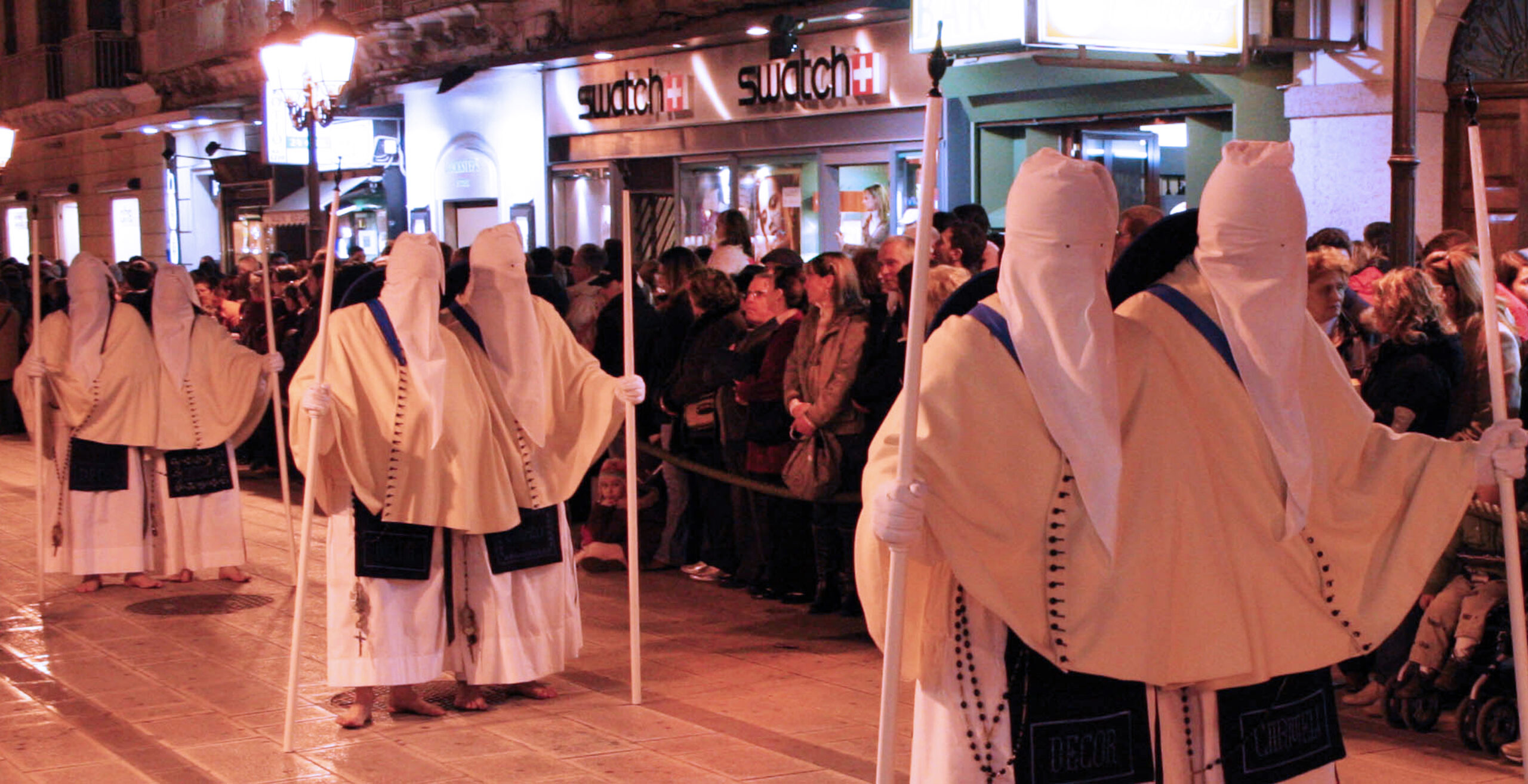Holy Week, the week preceding Easter, is the most sacred time of year for Catholics everywhere. In Italy, this solemn time is called La Settimana Santa and is marked with ancient processions that commemorate the passion, death and resurrection of Jesus Christ. This year, the holiest time is very different and is heartbreaking on many levels, especially for devoted Catholics in Italy. People from around the world usually travel to the country to take part in elaborate, deeply moving religious ceremonies. Although travel is curtailed, Italians will still find a way to celebrate the days of La Settimana Santa with various rituals that blend faith and tradition, even if community contact is prohibited and social distancing is the present reality.
La Domenica delle Palme (Palm Sunday)
Palm Sunday or La Domenica delle Palme, marks the beginning of Holy Week. In towns throughout Italy, worshipers carry crosses made from palm fronds and olive branches as they return from church. Since olive trees are far more abundant than palm trees in Italy, olive branches are more commonly presented on La Domenica delle Palme. Occasionally priests carry finely woven palm fronds, but most Italians carry olive branches that are handed out at the entrance to the church.
Lunedì Santo (Holy Monday)
On Lunedì Santo or Holy Monday, a large celebration has historically taken place in Castelsardo, a Sardinian town famous for its elaborate Holy Week celebrations. The faithful would mark the day with a ritual called Lunissanti, which begins at dawn and continue through the night. Wearing capes, leather belts and hoods, members of the Confraternita di S. Croce, or Brotherhood of the Holy Cross, assemble at the Holy Maria of Tergu Church, where traditional rites and religious ceremonies are celebrated. When the sun rises, the Mass would end and the holy and solemn procession through the town would begin.
Martedì Santo (Holy Tuesday)
In the Sardinian village of Iglesias, the first Holy Week activity takes place on Martedì Santo, with the procession of “The Mysteries.” Seven statues representing various moments of the Passion of Christ are carried around the city streets. A small chair decorated with flowers and olive branches symbolizing the Garden of Gethsemane is followed by Christ imprisoned, Christ scourged, Christ crowned with thorns, Christ walking towards Calvary, Christ crucified and finally, the image of the Madonna Addolorata.
Giovedì Santo (Holy Thursday)
Across Italy, it is traditional for those of the Catholic faith to attend Mass in the late afternoon or early evening of Giovedì Santo (Holy Thursday) for the Mass of the Last Supper. In a gesture of humility, priests, Bishops and even the Pope himself, would recreate Christ’s bathing of the feet of the Apostles, by washing the feet of twelve parishioners.
On Holy Thursday, all church bells, including handheld altar bells, are silenced across Italy until the Easter Vigil Mass on Holy Saturday, but that does not mean that all is quiet. In the north of Italy, near the border with France, lies Ceriana, the Singing Village. On the afternoon of Holy Thursday, the sound of spiral longhorns made from chestnut bark would herald the beginning of the commemorations. A procession would then wander through the village’s alleys with hooded clergymen draped in a traditional dress, each wearing a cape in one of the colors of the four confraternities. Throughout the procession, choral singing would create a ceremony that is as unique as it is beautiful.
Further south in Montalto Ligure, during the night between Holy Thursday and Good Friday, a group of men and boys would sing sacred chants to the melancholic, yet mournful sounds of a trumpets and drums as they walk through the old streets of the village. This year, the sounds will instead come from indoors, but the tradition will continue.
Also in the region of Ligure is the village of Molini di Triora. Holy Thursday is normally celebrated following afternoon Mass with a procession and ritual ‘Visit to the Tombs’ at the various churches and chapels in the village. The day would end with a traditional fresciöi-based dinner – fried breaded vegetables.
In the region of Puglia on Holy Thursday, the city of Taranto is known for its procession of the Addolorata or Our Lady of Sorrows. Beginning at midnight, the procession would follow a long route through the town, not returning until the following afternoon. The following day, Good Friday, at five o’clock, a procession would depart from the Church of St. Mary of Carmel for another lengthy pilgrimage, returning the following morning. The pilgrims, called perdoni, walk bare-footed and cover their faces with hoods. This slow and prolonged march may take almost three hours to cover the distance of a football field.
Venerdì Santo (Good Friday)
Good Friday is a major Catholic holy day. A good number of people undergo fasting on this solemn day. Many churches will cover their statues and crucifixes in black or purple cloth to signify that they are in mourning over the death of Christ. The most traditional event is the Via Crucis or Way of the Cross. This is particularly special in Rome, where the Pope would preside over a procession from the Colosseum to the Palatine Hill.
In any other year, many villages in Italy would stage dramatic processions and the Stations of the Cross for Venerdì Santo. The oldest Good Friday procession in Italy is that of the city of Chieti in the Abruzzo region, which would feature 100 violinists playing Selecchi’s “Miserere.” Historically, one of the most beloved Venerdi Santo processions takes place in Savona in Liguria. The origin of the procession can be traced back to the first festivals of medieval Brotherhoods. Beginning in the 17th century, the procession was enriched by elaborate statues that depicted scenes of the life of Christ. The procession begins with the Croce di Passione (Cross of Passion), followed by fourteen statues, the final being the Arca San Croce (Saint Cross Arc), which contains a sacred relic from the Cross of Christ
In Sorrento, near the Amalfi Coast, there are normally two Good Friday processions – the white procession in the morning, with participants wearing white, symbolic of Mary’s hope as she searches for her son and the black procession in the evening, in which the color black represents Mary’s sorrow as she beholds her son’s lifeless body.
In Calitri, in the province of Avellino, members of the Archconfraternity of the Immaculate Conception dress in white, with their heads hooded and crowned with thorns. They carry a cross on their shoulders up to the hill of Calvary. This rite dates back to the period of the first crusade, when a knight brought back a piece of the Cross from the Holy Land.
Further south on the island of Sicily, in Enna, more than 2,000 friars dressed in ancient costumes would march through the streets on Venerdì Santo. In the town of Ispica, processions would begin on Holy Thursday with U Patri a Culonna – Christ tied at the column. This ceremony would include a parade of the Confrati of Santa Maria Maggiore, wearing traditional red vests. On Good Friday, U Patri a Cruci – Christ carrying the cross, would be a procession led by the Confrati of the Annunziata Church wearing blue vests. On Easter Sunday, the two confraternite would be reunited for the procession of the Risuscitatu – Christ Resurrected, with the meeting between the statues of Jesus and the Virgin Mary.
Sabato Santo (Holy Saturday)
Sabato Santo (Holy Saturday) is a day of silence and prayer in honor of the dead Christ. Mass is not celebrated and the tabernacle, which usually contains Communion hosts, is left empty and open. After sundown, the solemn Easter Vigil begins with the liturgy of fire and the lighting of the Easter candle, which represents the “Light of Christ.” Readings from the Gospels would recount the appearance of the angels to the women who came to the tomb in search of Christ. During the liturgy of the baptism, all the faithful would renew their baptismal vows.
One of the few traditional Holy Saturday events is associated with Montalto Ligure in Liguria, where residents would mark the day with a procession of papier-mâché statues representing the various Stations of the Cross. The Holy Week festivities in the valleys of the Alps of Liguria are marked by their mysticism and their strong sense of tradition. Here lies a concentration of villages where processions of hooded penitents and medieval musical repertoires have been handed down through generations.





